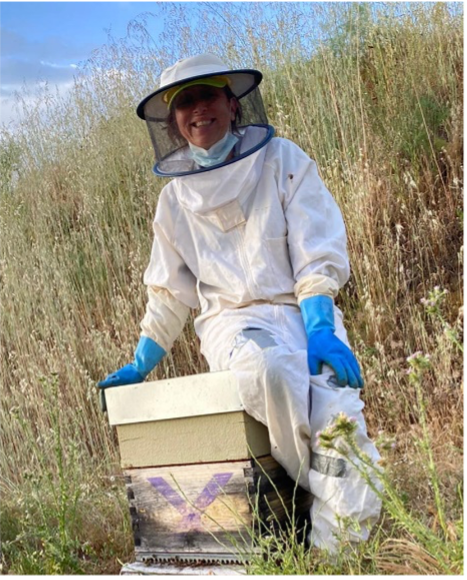

AGSx Virtual Symposium Spring 2022
Key Dates
Overview
Registration
Schedule
Mailing List
Organizing Committee and Production Team
Key Dates
Wednesday, February 9 - Session 1: Insect Genomic Technologies to Improve Food Applications
Wednesday, March 9 - Session 2: Honeybee Workshop
Tuesday, April 12 - Session 3: Arthropod Genomics and Genome Engineering
Tuesday, May 10 - Session 4: Application of New Genomics Tools and Techniques in Arthropods
Overview
Welcome to the AGSx Virtual Symposium Spring 2022. AGSx is organized and held independent of the annual Arthropod Genomics Symposium (AGS). Goals of the AGSx symposia are to highlight recent advances in Arthropod genomics, on topics from genome assembly, editing and engineering, and focused areas of insects as food and honey bee research. This is an opportunity for additional exchange of ideas and community interaction.
AGSx is composed of four separate virtual webinars from February to May, 2022. Symposia sessions are listed below, and more specific details on speakers will be updated as information becomes available. Questions and open discussions will follow speaker presentations.
Sessions are being recorded and videos are posted within a week of when the session occurs. Once available you will be able to click “Video Recording” at the top of the speaker information table for a link to the session’s recording, available through the i5k Community YouTube Channel. Subscribe to the channel to be notified when new videos are posted.
Registration
Participants are directed to register for one or all symposia sections free of charge using this form. Additional information on presentations and Zoom connections for each session will be announced via a registration email list.
Additionally, those interested in continuing the discussions from these sessions or engaging more broadly with the i5k community are welcome to join the Arthropod Genomics Community Slack Workspace using this link.
Schedule
February 9
Organized and moderated by Brenda Oppert, USDA ARS, Stored Product Insect and Engineering Research Unit, Manhattan, KS.
| Session 1: Insect Genomic Technologies to Improve Food Applications | Video Recording |
|---|---|
 Kelsy Robinson Kelsy Robinson Research Biologist (Immunology), USDA ARS Poultry Research Unit, Mississippi State, Mississippi | Title: Debugging a new mini livestock commodity: Advancing insects a feed through a USDA Grand Challenge research approach Summary: A steady increase in global population, food insecurity issues, and global warming demands an increased food/feed output from available agro-ecosystems while decreasing environmental impact. Feed production accounts for 45% of greenhouse gas emissions from livestock and is prone to supply disruptions making its availability one of the biggest hurdles to achieving sustainable livestock production. Insects have the potential to increase livestock sustainability and help meet production needs by serving as an alternative protein source for animal diets. Insects are nutrient dense and can be reared sustainably in a wide variety of environments. While developing feeds from insect-based ingredients is an attractive option, more research is needed to ensure safe and reliable insect production and adoption of insect-based diets for food animal species in the United States. ARS has implemented a Grand Challenge initiative to encourage synergistic research approaches to address critical research needs. The Insect Grand Challenge initiated in 2020 includes 42 ARS scientists representing 11 National Programs and 22 Research Units across the US and Greece as well as academic partners and industry stakeholders. This team is working to develop a model that incorporates economics, food animals (poultry, aquaculture and livestock), infrastructure and sustainable ecological insect production systems to investigate the value-add of rearing insects on waste diets and quality assurance of resulting meal answering much needed research questions. Research includes innovation of insect production facilities and processing techniques, refining of insect nutrition and production, development of genetically-improved insect livestock, and optimizing inclusion of insect meal in animal diets. Data gained from this project will provide valuable information that will provide needed support to the U.S. insect industry as a new livestock commodity. |
 Christine J. Picard Christine J. Picard Associate Professor, Biology and Director, Forensic and Investigative Sciences (FIS) Program, Indiana University–Purdue University Indianapolis, Indiana | Title: Genetic and genomic selection in insects as food and feed Summary: The insect agriculture industry is poised to be the sustainable alternative protein of the future. As it develops, and unlike traditional agriculture, there is not the time to breed optimal strains without technology, and luckily, it is readily available. This presentation will highlight some areas where genetics and genomics can play a role in increasing production value and the sustainability profile of insects for food and feed applications. |
March 9
Organized and moderated by Drs. Alain Vignal & Sonia Eynard, INRAE, Castanet Tolosan, France
| Session 2: Honeybee Workshop | Video Recording |
 M. Alice Pinto M. Alice Pinto Coordinator Professor in the School of Agriculture at the Polyethnic Institute of Bragança, Portugal | Title: Iberia: an important stage of honey bee, Apis mellifera, evolution Summary: The origin of the honey bee, Apis mellifera, has been under debate with two competing hypotheses placing it in either Africa or Asia. In both scenarios, Iberia seems to have acted as an important stage in A. mellifera evolutionary history because of its close proximity to Africa and because it was an important refuge during the ice ages. Therefore, uncovering the Iberian honey bee (A.m. iberiensis) diversity patterns, and underlying processes, is also revealing an important component of the A. mellifera history. Here, I will show the results of a genome-wide scan and whole genome analysis to disentangle selective and neutral patterns of population structure across the entire range of the Iberian honey bee. It will be evident that selection and secondary contact have acted together to shape extant diversity patterns and that contemporary human-mediated processes seem to play a negligible role, despite large-scale migratory beekeeping. I will highlight the questions that remain unanswered in the Iberian honey bee history and the importance of a full knowledge of diversity patterns when designing SNP-based tools. |
 Garett Slater Garett Slater PhD Candidate, Department of Entomology, Purdue University, Indiana | Title: Using genomics to predict drone quality: Why are there so many ‘dud’ male honey bees? Summary: The cause of queen failure is of deep importance to beekeepers and researchers alike. While much energy has focused on queens, we are increasingly discovering that drones play a more important role in queen quality than originally expected. If drones are not producing healthy sperm, their mates will not produce healthy colonies. We are beginning to understand the proximate causes of variation in of honey bee male (drone) fertility; however, the ultimate causes remain elusive. My work will explore how genetic variation within North America can influence reproductive quality in honeybee males. In this talk, I discuss how both haploid selection and polyandry impact the evolution, divergence and genetic diversity of male reproductive genes. I also discuss how these factors contribute to the phenotypic variation in drone reproductive traits observed among honey bee stocks in North America. |
 Jana Obšteter Jana Obšteter Research Associate, Agricultural Institute of Slovenia, Ljubljana, Slovenia | Title: SIMplyBee – stochastic modeling of genetic and breeding processes in honeybee populations Summary: Computer simulations are a valuable tool for optimizing breeding programs and developing new methodologies. The existing simulators focus either on common livestock or crop species and are not suitable for honeybees due to their genetic, reproductive, and environmental specificities. While honeybee specific simulators have been developed, they operate on a colony level and usually do not model the seasonal cycle of a colony. We have developed an R package SIMplyBee that provides honeybee extensions for the AlphaSimR simulator. SIMplyBee operates on an individual level but with colony and colonies classes, with the latter representing either an apiary or an entire population of colonies. SIMplyBee provides functionality for simulating genomes, genetic and phenotypic values at an individual as well as the colony level. It also includes the functionality to model colony events throughout the year and across years. For example, SIMplyBee enables the user to simulate major events, such as creating drone congregation areas, mating of the queen, swarming, supersedure, split, build-up of the colony, and collapse of the colony. SIMplyBee also allows for the monitoring of genetic and phenotypic trends, as well as genetic variability of the colony or population. In addition, it simulates the csd locus with flexible number of alleles and allows for elimination of homozygous drones. In its final form, SIMplyBee will also include a spatial component of honeybee populations to account for dynamics related to natural mating or environmental effects, and allow for simulating multiple subspecies of honeybees. In this talk, I will present the functionality of the simulator and the results from some early-stage simulations. |
April 12
Organized and moderated by Dr. Lindsey Perkin, USDA-ARS, College Station, TX, USA
| Session 3: Arthropod Genomics and Genome Engineering | Video Recording |
|---|---|
 Noah Rose Noah Rose Postdoctoral Fellow, Princeton University, Princeton, New Jersey | Title: The Origin and Spread of Preference for Humans in the Dengue, Zika, and Yellow Fever Mosquito Summary: Of thousands of species of mosquitoes, just a handful present the greatest threats to public health: those species that have recently evolved a strong preference for human hosts and habitats. I will discuss the results of a set of whole-genome demographic analyses in Aedes aegypti, the globally invasive primary vector of dengue, Zika, chikungunya, and yellow fever. Previous work has shown that behavioral preference for human hosts is largely explained by two main ecological factors: the intensity of dry seasons, and human population density. By combining ecological and genomic analyses, we can identify three major phases in the history of this vector. Specialization on human hosts likely first evolved several thousand years ago in the highly seasonal habitats of the Sahel, where natural habitat for aquatic mosquito larvae is scarce across the long, hot dry season, but human water storage provides an ideal niche. Next, these human-specialist populations spread to the Americas, where they were responsible for devastating outbreaks of yellow fever and other arboviruses; these invasive populations subsequently spread across the global tropics. Now, in rapidly growing cities across sub-Saharan Africa, urbanization effects are beginning to dominate, and our models suggest that Aedes aegypti populations are becoming more specialized on human hosts. |
 Zach Cohen Zach Cohen Postdoctoral Research Molecular Biologist, USDA-ARS, Insect Control and Cotton Disease Research Unit, College Station, TX | Title: Whole Genome Synteny Between Anthonomous Pest and Non-pest Subspecies Weevils Macro Inversions Summary: The boll weevil, Anthonomus grandis grandis, is an infamous pest of commercial cotton. Eradication programs have been largely successful in the U.S., but remaining boll weevil populations in south Texas remain problematic and threaten eradicated areas across the cotton belt. Moreover, the boll weevil has a morphologically similar non-pest subspecies, the thurberia weevil, Anthonomus grandis thurberiae, that feeds on wild cotton. Unfortunately, boll weevil pheromone traps also attract thurberia weevil and can cause a cascade of costly mitigation procedures if misidentified as a boll weevil. Diagnostic assays are currently under development to quickly decipher the two subspecies, but larger questions about the biology and genetic differences between the two weevils remain unanswered. In this presentation I will discuss a whole genome comparison between the boll weevil and thurberia weevil, focusing on two macro inversions. |
 Susan Noh Susan Noh Research Veterinary Medical Officer, USDA-ARS Animal Disease Research Unit, Washington State University, Pullman, WA  Perot Saelao Perot Saelao Molecular Biologist (Bioinformatics), Livestock Insects Research Laboratory, Kerrville, TX | Title: TickTok: A short videoed update on the comparative analysis of tick genomes sequenced within the USDA Summary: Dermacentor andersoni, also known as the Rocky Mountain wood tick, transmits viral and bacterial pathogens to humans and animals including Rickettsia rickettsii, which causes Rocky Mountain spotted fever, Francisella tularensis, the cause of tularemia, Colorado tick fever virus, and Anaplasam marginale, the cause of bovine anaplasmosis. Transmission of these intracellular pathogens requires direct interaction between the pathogen and tick cells. Our lack of understanding of basic tick physiology and cellular biology limit our ability to understand the tick-pathogen interactions and thus impedes progress toward developing tools to prevent these tick borne diseases. In collaboration with Ag100Pest, we have sequenced and assembled a high-quality D. andersoni genome to address these limitations. Here we will be discussing our investigation into these ticks’ genetic structure and diversity along with the genetic complexity found within and between tick species. Our overall goal is to highlight the invaluable resources developed within USDA and how they can directly benefit the tick research community. |
May 10
Organized and moderated by Dr. Marcé D. Lorenzen, North Carolina State University, Raleigh, NC, USA
| Session 4: Application of New Genomics Tools and Techniques in Arthropods | May 10, 2022 10am-12pm am CST/ 11am-1pm EST/ 5-7pm CET |
 Michael Smanski Michael Smanski Department of Biochemistry, Molecular Biology, and Biophysics and the BioTechnology Institute, University of Minnesota, Minnesota | Title: Synergistic behavior of combining genetic biocontrol techniques Summary: This talk will describe (i) efforts to create an underdominance-based genetic biocontrol strategy in insects, (ii) its combination with a sex-ratio biasing construct, and (iii) the performance of the combined approach in mixed-generation cage trials. I will share results demonstrating how an unexpected synergism of the two genetic methods allows for a tunable persistence of the biocontrol agent post-release. |
 Yolanda Chen Yolanda Chen Department of Plant and Soil Science, University of Vermont, Burlington, Vermont | Title: Sublethal insecticide exposure and epigenetic inheritance in the Colorado potato beetle, Leptinotarsa decemlineata Summary: Insect pests display an extraordinary ability to rapidly evolve resistance to insecticides. Although the evolution of insecticide resistance is widely considered to be inevitable, the underlying processes on how it occurs so rapidly remains poorly understood. One possible but largely unexplored explanation is that exposure to sublethal doses of insecticides may alter heritable epigenetic patterns. DNA methylation of cytosine nucleotides is one form of epigenetic modifications, which can alter heritable patterns of gene expression without changing the underlying genetic code. Therefore, sublethal exposure may influence the emergence of resistant phenotypes in complex ways. We assessed how exposure to sublethal doses of the neonicotinoid imidacloprid influences DNA methylation in the parent and F2 generations of Colorado potato beetle, Leptinotarsa decemlineata. We tested three imidacloprid treatments: a high dose, low dose, and an imidacloprid compound modified to be less toxic. We examined global changes in DNA methylation as well as individual differentially methylated sites. We found that all insecticide treatments decreased global DNA methylation in the parent and F2 generations, regardless of the dosage. Across all treatments exposed to insecticides, 221 nucleotide sites showed differential methylation. The majority, or 39% of these sites, were found in areas annotated as transposable elements. Given the consistent DNA methylation treatment patterns across the parent and F2 generation, our data demonstrates how environmental exposure to insecticides can have intergenerational carryover effects. |
 Eric Tvedte Eric Tvedte Bioinformatics Data Wrangler, NCBI/NLM/NIH, Bethesda, Maryland | Title: Rapid detection of arthropod genome assembly contaminants using new tools from NCBI Summary: NCBI processes hundreds of thousands of genome submissions each year, contributing to a doubling of the sequence archives every 18 months and now containing over 15 terabases of sequence data. The quality of the sequence archives depends on the proper identification and removal of foreign contaminants. NCBI screens identified contamination from adaptors, foreign organisms, and other sources in over half of eukaryote genome submissions in 2021. Contamination in arthropod genome assemblies is common as arthropods often have an intimate relationship with other organisms. Even so, substantial contamination remains undetected by current screens. New public tools in development at NCBI will allow arthropod genome providers to rapidly identify contamination in newly assembled genomes. We have planned public releases for a cloud-based adaptor screen and a cross-species aligner to detect contamination from foreign organisms with sensitivity higher than other available methods. Using the cross-species aligner, we rapidly processed genome sequences (1-10 Mbp/sec) to identify over 50 Mbp of suspected contaminant sequences in current RefSeq arthropod genomes. |
Mailing List
To keep up to date with news about this conferece, the i5k webinar series and other i5k activities, please subscribe to the Arthropod News mailing list. Email frequency is typically very low.
Organizing Committee and Production Team
This virtual symposium series was brought to you through the efforts of the following organizing committee and production team:
- Brenda Oppert, USDA-ARS, Manhattan, KS, USA
- Alain Vignal, INRAE, Castanet Tolosan, France
- Sonia Eynard, INRAE, Castanet Tolosan, France
- Lindsey Perkin, USDA-ARS, College Station, TX, USA
- Marcé D. Lorenzen, North Carolina State University, Raleigh, NC, USA
- Glenn Hanes, USDA-ARS, Beltsville, MD, USA
- Anna Childers, USDA-ARS, Beltsville, MD, USA
- Robert Waterhouse, University of Lausanne, Switzerland
- Brad Coates, USDA-ARS, Ames, IA, USA